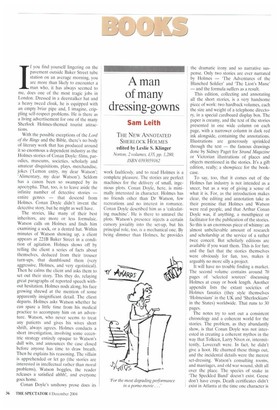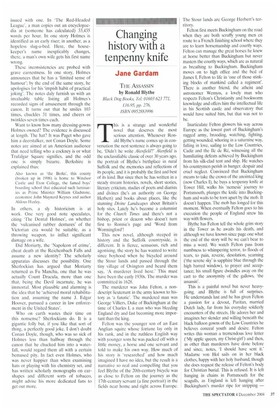A man of many dressing-gowns
Sam Leith
THE NEW ANNOTATED SHERLOCK HOLMES edited by Leslie S. Klinger Norton, 2 volumes, £35, pp. 1,280, ISBN 0393059162 If you find yourself lingering on the pavement outside Baker Street tube station on an average morning, you are more than likely to encounter a man who, it has always seemed to me, does one of the most tragic jobs in London. Dressed in a deerstalker hat and a heavy tweed cloak, he is equipped with an empty briar pipe and, I imagine, crippling self-respect problems. He is there as a living advertisement for one of the many Sherlock Holmes-themed tourist attractions.
With the possible exceptions of the Lord of the Rings and the Bible, there's no body of literary work that has produced around it so enormous a dependent industry as the Holmes stories of Conan Doyle: films, parodies, museums, societies, scholarly and amateur disquisitions, plays, merchandise, jokes ('Lemon entry, my dear Watson': 'Alimentary, my dear Watson'). Seldom has a canon been so swamped by its apocrypha. That, too, is to leave aside the infinite number of detective stories — entire genres — that descend from Holmes. Conan Doyle didn't invent the detective story, but he might as well have.
The stories, like many of their best inheritors, are more or less formulaic. Watson calls on Holmes and finds him examining a sock, or a dented hat. Within minutes of Watson showing up, a client appears at 221B Baker Street in a condition of agitation. Holmes shows off by telling the client a series of facts about themselves, deduced from their trouser turn-ups, that dumbfound them (very aggressive, Holmes, and very egotistical). Then he calms the client and asks them to set out their story. This they do, relaying great paragraphs of reported speech without hesitation. Holmes nods along, his face growing shrewd at the mention of some apparently insignificant detail. The client departs. Holmes asks Watson whether he can spare a little time from his medical practice to accompany him on an adventure. Watson, who never seems to treat any patients and gives his wives short shrift, always agrees. Holmes conducts a short investigation, involving some eccentric strategy entirely opaque to Watson's dull wits, and announces the case closed before anyone has time to draw breath. Then he explains his reasoning. The villain is apprehended or let go (the stories are interested in intellectual rather than moral problems), Watson boggles, the reader releases a satisfied ahhh!, and everyone goes home.
Conan Doyle's unshowy prose does its work faultlessly, and to read Holmes is a complete pleasure. The stories are perfect machines for the delivery of small, ingenious plots. Conan Doyle, here, is minimally interested in character. Holmes has no friends other than Dr Watson, few recreations and no interest in romance. Conan Doyle described him as a 'calculating machine'. He is there to unravel the plots. Watson's presence injects a certain cursory joviality into the set-up, but his principal role, too, is a mechanical one. By being dimmer than Holmes, he provides the dramatic irony and so narrative suspense. Only two stories are ever narrated by Holmes — The Adventures of the Blanched Soldier' and 'The Lion's Mane' — and the formula suffers as a result.
This edition, collecting and annotating all the short stories, is a very handsome piece of work: two hardback volumes, each the size and weight of a telephone directory, in a special cardboard display box. The paper is creamy, and the text of the stories presented in one wide column on each page, with a narrower column in dark red ink alongside, containing the annotations. Illustrations are generously sprinkled through the text — the famous drawings done by Sidney Paget for Strand Magazine or Victorian illustrations of places and objects mentioned in the stories. It's a gift edition, really; a showpiece for the bookcase.
To say, too, that it comes out of the Holmes fan industry is not intended as a sneer, but as a way of giving a sense of what it is. For, as the introduction makes clear, the editing and annotation take as their premise that Holmes and Watson were real people, and that Arthur Conan Doyle was, if anything, a mouthpiece or facilitator for the publication of the stories. So this is an enormous piece of whimsy; an almost unbelievable amount of research and scholarship at the service of a rather twee conceit. But scholarly editions are available if you want them. This is for fun; and the fact that the stories themselves were obviously for fun, too, makes it arguably no more silly a project.
It will have no trouble finding a market. The second volume contains around 70 pages of 'selected sources' discussing Holmes at essay or book length. Another appendix lists the extant societies of Holmes fanatics (they style themselves `Holmesians' in the UK and `Sherlockians' in the States) worldwide. That runs to 30 pages.
The notes try to sort out a consistent chronology and a coherent world for the stories. The problem, as they abundantly show, is that Conan Doyle was not interested in creating a coherent mythos in the way that Tolkien, Larry Niven or, intermittently, Lovecraft were. In fact, he didn't give a hoot. He churned these things out, and the incidental details were the merest set-dressing. Watson's consulting rooms, and marriages, and old war wound, shift all over the place. The species of snake in 'The Speckled Band' doesn't exist. Geese don't have crops. Death certificates didn't exist in Atlanta at the time one character is
issued with one. In 'The Red-Headed League', a man copies out an encyclopaedia at (someone has calculated) 33,435 words per hour. In one story Holmes is identified as an early riser; in another, as a hopeless slug-a-bed. Here, the housekeeper's name inexplicably changes, there, a man's own wife gets his first name wrong.
These inconsistencies are probed with grave earnestness. In one story, Holmes announces that he has a 'limited sense of humour'; by the end of the same story, he apologises for his 'impish habit of practical joking'. The notes duly furnish us with an invaluable table listing all Holmes's recorded signs of amusement through the canon. It turns out that he smiles 103 times, chuckles 31 times, and cheers or twinkles seven times each.
Want to know how many dressing-gowns Holmes owned? The evidence is discussed at length. The hat? It was Paget who gave him a deerstalker, not Conan Doyle. Some notes are aimed at an American audience that need telling who a cockney is or what Trafalgar Square signifies, and the odd one is simply bizarre. Berkshire is explained thus:
Also known as the Berks', this county (broken up in 1998) is home to Windsor Castle and Eton College, the famed boys' boarding school that educated such luminaries as Prime Minister William Gladstone, economist John Maynard Keynes and author Aldous Huxley.
In others, a sly historicism is at work. One very good note speculates, citing 'The Dental Holmes', on whether the 'vulcanised rubber dentures' of the Victorian era would be suitable, as a throwing weapon, to inflict significant damage on a wife.
Did Moriarty, the 'Napoleon of crime', cheat death at the Reichenbach Falls and assume a new identity? The scholarly apparatus discusses the possibility. One Sherlockian has argued that Moriarty returned as Fu Manchu, one that he was actually Count Dracula, more than one that, being the Devil incarnate, he was immortal. Most plausible and alarming is the idea that he 'achieved moral rehabilitation and, assuming the name J. Edgar Hoover, pursued a career in law enforcement in the United States'.
Who on earth wastes their time on this nonsense? Sherlockians do. It is a gigantic folly but, if you like that sort of thing, a perfectly good joke. I don't doubt Conan Doyle, though, who was so sick of Holmes less than halfway through the canon that he chucked him into a waterfall, would regard them all with a certain bemused pity. In fact even Holmes, who was never happier than when examining hats or playing with his chemistry set, and has written scholarly monographs on earshapes and different sorts of tobacco, might advise his more dedicated fans to get out more.



















































































 Previous page
Previous page